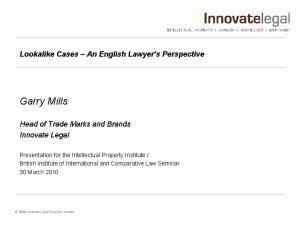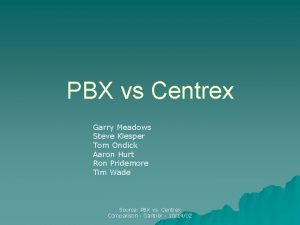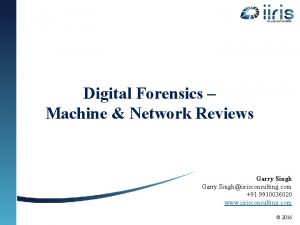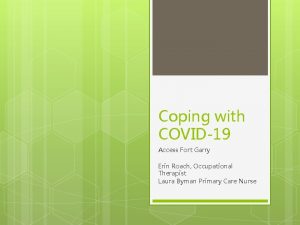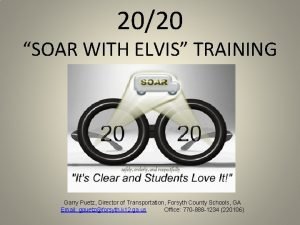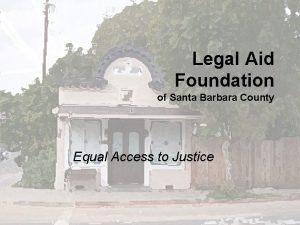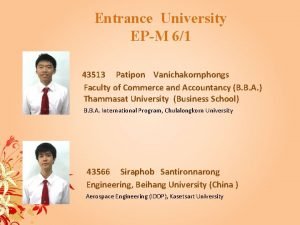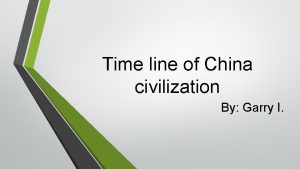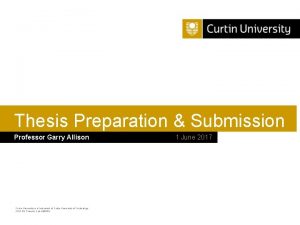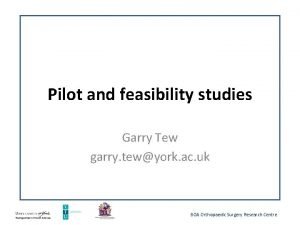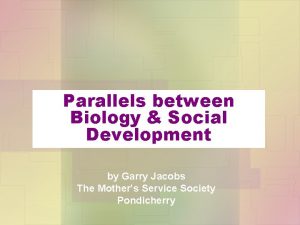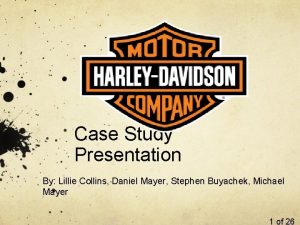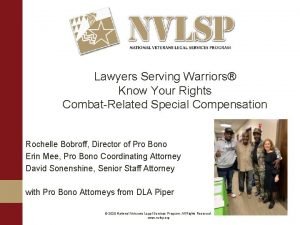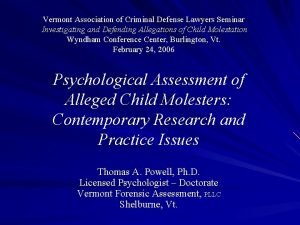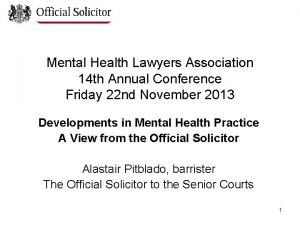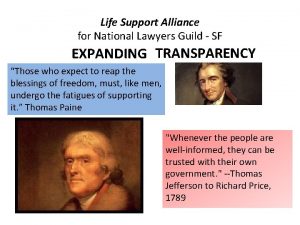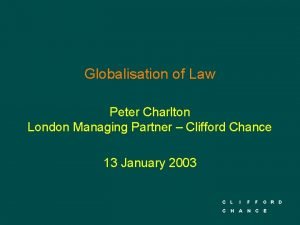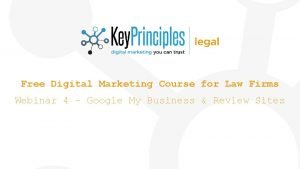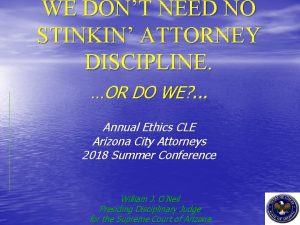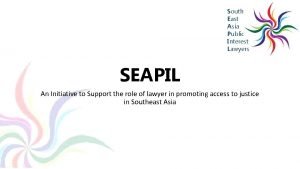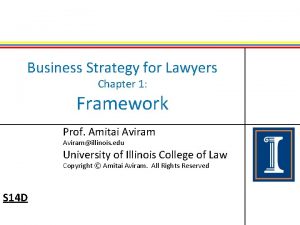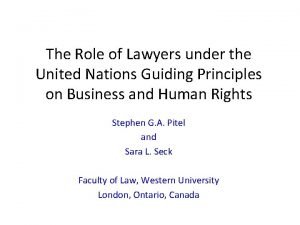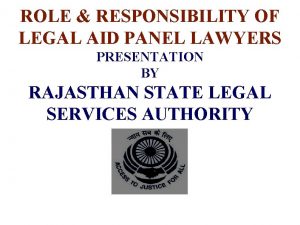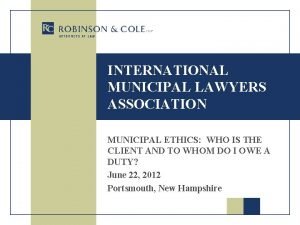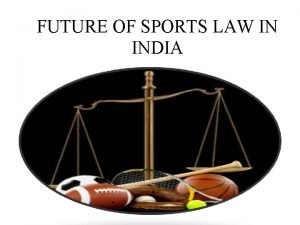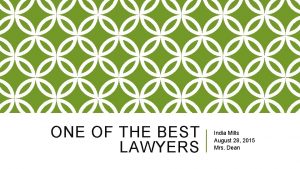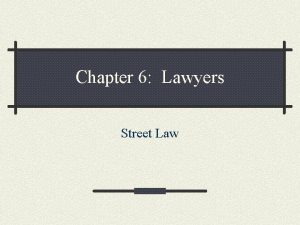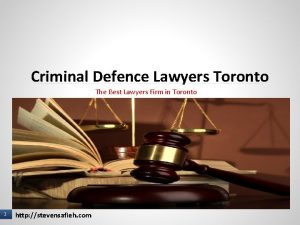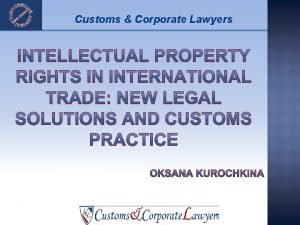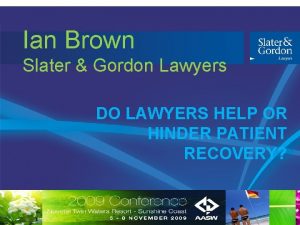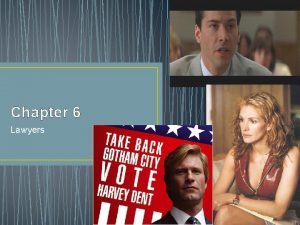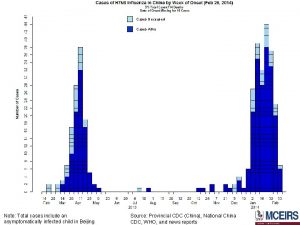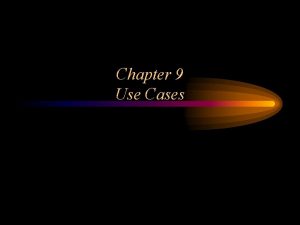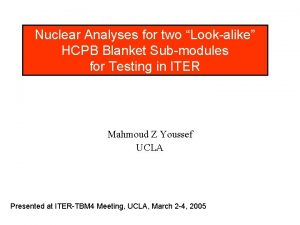Lookalike Cases An English Lawyers Perspective Garry Mills





![A historical perspective The Pub Squash case [1981, House of Lords] The Claimant objected A historical perspective The Pub Squash case [1981, House of Lords] The Claimant objected](https://slidetodoc.com/presentation_image/a66786f6cb36b7eb11dead77b60d311e/image-6.jpg)
![A historical perspective The Pub Squash case [House of Lords, 1981]. . . the A historical perspective The Pub Squash case [House of Lords, 1981]. . . the](https://slidetodoc.com/presentation_image/a66786f6cb36b7eb11dead77b60d311e/image-7.jpg)





![The Tubzee case [2008]: Claimant’s and Defendant’s products © 2008 Innovate Legal Services Limited The Tubzee case [2008]: Claimant’s and Defendant’s products © 2008 Innovate Legal Services Limited](https://slidetodoc.com/presentation_image/a66786f6cb36b7eb11dead77b60d311e/image-13.jpg)
![Proof of deception/confusion in lookalike cases The Tubzee case [2008] The Claimant received letters Proof of deception/confusion in lookalike cases The Tubzee case [2008] The Claimant received letters](https://slidetodoc.com/presentation_image/a66786f6cb36b7eb11dead77b60d311e/image-14.jpg)




![Proof of confusion: Magic Tree [2006] Claimant’s and Defendant’s products: © 2008 Innovate Legal Proof of confusion: Magic Tree [2006] Claimant’s and Defendant’s products: © 2008 Innovate Legal](https://slidetodoc.com/presentation_image/a66786f6cb36b7eb11dead77b60d311e/image-19.jpg)
![Proof of confusion: Magic Tree [2006] – Defendant’s product had been on sale for Proof of confusion: Magic Tree [2006] – Defendant’s product had been on sale for](https://slidetodoc.com/presentation_image/a66786f6cb36b7eb11dead77b60d311e/image-20.jpg)
![Proof of confusion – other evidence VODKAT [2010] “Extended” passing off case: did customers Proof of confusion – other evidence VODKAT [2010] “Extended” passing off case: did customers](https://slidetodoc.com/presentation_image/a66786f6cb36b7eb11dead77b60d311e/image-21.jpg)

![Proof of dilution/free riding: L’OREAL [2006, first instance] Claimant’s and Defendant’s bottles: © 2008 Proof of dilution/free riding: L’OREAL [2006, first instance] Claimant’s and Defendant’s bottles: © 2008](https://slidetodoc.com/presentation_image/a66786f6cb36b7eb11dead77b60d311e/image-23.jpg)
![Proof of dilution/free riding L’Oréal [2006, first instance] – Defendant’s ‘smell-alike’ perfume products had Proof of dilution/free riding L’Oréal [2006, first instance] – Defendant’s ‘smell-alike’ perfume products had](https://slidetodoc.com/presentation_image/a66786f6cb36b7eb11dead77b60d311e/image-24.jpg)
![Proof of dilution/free riding: Whirlpool/KMIX [2008] Claimant’s product: © 2008 Innovate Legal Services Limited Proof of dilution/free riding: Whirlpool/KMIX [2008] Claimant’s product: © 2008 Innovate Legal Services Limited](https://slidetodoc.com/presentation_image/a66786f6cb36b7eb11dead77b60d311e/image-25.jpg)
![Proof of dilution/free riding Whirlpool/KMIX [2008, first instance] – – – – Claimant started Proof of dilution/free riding Whirlpool/KMIX [2008, first instance] – – – – Claimant started](https://slidetodoc.com/presentation_image/a66786f6cb36b7eb11dead77b60d311e/image-26.jpg)
![Other causes of action - Copyright IDEAL HOME v HOME [2004] Claimant’s and Defendant’s Other causes of action - Copyright IDEAL HOME v HOME [2004] Claimant’s and Defendant’s](https://slidetodoc.com/presentation_image/a66786f6cb36b7eb11dead77b60d311e/image-27.jpg)
![Other causes of action - Copyright IDEAL HOME v HOME [2004] Claimant alleged that Other causes of action - Copyright IDEAL HOME v HOME [2004] Claimant alleged that](https://slidetodoc.com/presentation_image/a66786f6cb36b7eb11dead77b60d311e/image-28.jpg)




- Slides: 32

Lookalike Cases – An English Lawyer’s Perspective Garry Mills Head of Trade Marks and Brands Innovate Legal Presentation for the Intellectual Property Institute / British Institute of International and Comparative Law Seminar 30 March 2010 © 2008 Innovate Legal Services Limited

Overview of presentation 1. Introduction – the IPI/BIICL survey 2. A historical perspective 3. Why are the legal costs in English proceedings so high? 4. Proving confusion and/or “free riding” in lookalike cases 5. Other causes of action 6. Conclusions © 2008 Innovate Legal Services Limited

Introduction: the IPI/BIICL survey The 2 key messages: - Compared to equivalent proceedings elsewhere in Europe, English cases are far more expensive - English courts are generally perceived as offering a lower degree of protection against lookalikes than their European counterparts Why? © 2008 Innovate Legal Services Limited

A historical perspective Disputes over lookalike products are nothing new. . . cases involving complaints by brandowners about products imitating get-up can be traced back to the late 19 th Century. Get-up cases have generally been decided on the basis of passing off and/or trade mark infringement as the main cause of action. Only a handful of cases have succeeded in the last 10 -15 years. © 2008 Innovate Legal Services Limited

A historical perspective The way in which the English Courts have approached get-up cases has reflected their desire to strike a balance between: - competition . . . generally - brandowners’ rights © 2008 Innovate Legal Services Limited to be encouraged . . . not to be overreached!
![A historical perspective The Pub Squash case 1981 House of Lords The Claimant objected A historical perspective The Pub Squash case [1981, House of Lords] The Claimant objected](https://slidetodoc.com/presentation_image/a66786f6cb36b7eb11dead77b60d311e/image-6.jpg)
A historical perspective The Pub Squash case [1981, House of Lords] The Claimant objected to similarities in the Defendant’s get-up for its soft drink, as well as themes used in its advertising campaign. There was evidence that the Defendant was deliberately trying to trade on the reputation of the Claimant’s product, but. . . © 2008 Innovate Legal Services Limited
![A historical perspective The Pub Squash case House of Lords 1981 the A historical perspective The Pub Squash case [House of Lords, 1981]. . . the](https://slidetodoc.com/presentation_image/a66786f6cb36b7eb11dead77b60d311e/image-7.jpg)
A historical perspective The Pub Squash case [House of Lords, 1981]. . . the case failed. “In reaching his conclusion. . . the judge had. . . to bear in mind the necessity in this branch of the law the balance to be maintained between the protection of a plaintiff’s reputation in his product and the protection of free competition. It is only if a plaintiff can establish that a defendant has included his “intangible property right” in his product by misappropriating descriptions of the product that have become recognised by the market as distinctive of the product that the law will permit competition to be restricted. Any other approach would encourage monopoly”. - per Lord Scarman © 2008 Innovate Legal Services Limited

More recently. . . Striking a balance between competition and IP rights remains important. L’Oréal [2007, Court of Appeal] “. . . my concern is that EU trade mark law ought not to be over-protective. Freedom to compete or just to trade is an important foundation of the EU and should only be restricted, including by trade mark law, where necessary. Trade marks need protection to play their vital part in a competitive economy, but it is very questionable whether they need more protection than for that purpose”. - per Lord Justice Jacob © 2008 Innovate Legal Services Limited

What does this mean for litigants in lookalike cases? Experienced litigants appreciate that they have to overcome a free market philosophy that leads to judicial scepticism in many lookalike cases. As a consequence: - They know that any evidence relied on in a lookalike case is likely to be subjected to thorough and careful scrutiny, both by the Defendant and the Court - Their lawyers know that they have to do a first class job in preparing the evidence, if they are going to have any chance of winning © 2008 Innovate Legal Services Limited

What does this mean for litigants in lookalike cases? Before the English courts, no stone must be left unturned. . . need lots of evidence, which must be gathered and prepared thoroughly and very carefully Lots of work for the lawyers. . . = £££££ © 2008 Innovate Legal Services Limited

Proof of deception/confusion in lookalike cases Why is it so difficult to prove deception and confusion in lookalike cases in the English courts? Some thoughts. . . Lookalike products generally do not feature names that are similar to the brand name. Often, a retailer’s ‘house name’ will appear on the lookalike. Lookalike products generally avoid wholesale copying of design elements – often, only a small number of important visual elements are taken. © 2008 Innovate Legal Services Limited

Proof of deception/confusion in lookalike cases The best kind of proof is evidence from actual ‘punters’ who have bought the lookalike product by mistake. The Tubzee case [2008] Both parties manufactured “Kulfi” ice cream. . . © 2008 Innovate Legal Services Limited
![The Tubzee case 2008 Claimants and Defendants products 2008 Innovate Legal Services Limited The Tubzee case [2008]: Claimant’s and Defendant’s products © 2008 Innovate Legal Services Limited](https://slidetodoc.com/presentation_image/a66786f6cb36b7eb11dead77b60d311e/image-13.jpg)
The Tubzee case [2008]: Claimant’s and Defendant’s products © 2008 Innovate Legal Services Limited
![Proof of deceptionconfusion in lookalike cases The Tubzee case 2008 The Claimant received letters Proof of deception/confusion in lookalike cases The Tubzee case [2008] The Claimant received letters](https://slidetodoc.com/presentation_image/a66786f6cb36b7eb11dead77b60d311e/image-14.jpg)
Proof of deception/confusion in lookalike cases The Tubzee case [2008] The Claimant received letters from 2 customers shortly after the launch of the Defendant’s ice cream. They said that they had bought the Defendant’s product by mistake. This evidence – together with the similarities in the Defendant’s packaging – persuaded the Judge that there was a risk of confusion sufficient to amount to trade mark infringement and passing off. . but this evidence is often hard to come by. © 2008 Innovate Legal Services Limited

Proof of deception/confusion in lookalike cases It is rare for Claimants in lookalike cases to find evidence of actual confusion. Why? The Claimant may have raised objection to the Defendant’s product at an early stage of the launch, or even prior to the launch of the Defendant’s product, before any deception can occur. Where products are low value, fast-moving consumer goods, deceived customers may notice that they have bought the wrong product and if they do, they may not bother to complain. © 2008 Innovate Legal Services Limited

Proof of deception/confusion in lookalike cases - surveys In the absence of evidence of actual confusion, a putative Claimant must generate evidence of confusion in other ways, e. g. by means of a survey. Surveys Types of survey - Questionnaires - In-depth interviews with pre-selected members of the public © 2008 Innovate Legal Services Limited

Survey evidence The English Courts have often been wary of survey evidence. Frequently levelled criticisms: - Artificial and do not replicate the real-life shopping environment - Form of questions leading or invite speculation - Sloppily carried out Levels of confusion revealed by surveys can often understate the true position. People are wary of giving answers that will make them look careless or stupid. © 2008 Innovate Legal Services Limited

Survey evidence There is no doubt that the English Courts demand high standards before they will attribute any significant evidential weight to surveys. Therefore, surveys need to be: - Carefully designed - Well-executed - Backed up by live testimony from real witnesses Although survey evidence is often criticised, there have been cases where this kind of evidence has helped to win the case. Often, there is no other way to locate potential confusion witnesses. © 2008 Innovate Legal Services Limited
![Proof of confusion Magic Tree 2006 Claimants and Defendants products 2008 Innovate Legal Proof of confusion: Magic Tree [2006] Claimant’s and Defendant’s products: © 2008 Innovate Legal](https://slidetodoc.com/presentation_image/a66786f6cb36b7eb11dead77b60d311e/image-19.jpg)
Proof of confusion: Magic Tree [2006] Claimant’s and Defendant’s products: © 2008 Innovate Legal Services Limited
![Proof of confusion Magic Tree 2006 Defendants product had been on sale for Proof of confusion: Magic Tree [2006] – Defendant’s product had been on sale for](https://slidetodoc.com/presentation_image/a66786f6cb36b7eb11dead77b60d311e/image-20.jpg)
Proof of confusion: Magic Tree [2006] – Defendant’s product had been on sale for 2½ years by the time the case came to trial – The Claimant had no evidence of actual confusion – The Claimant surveyed 307 members of the public and 149 of the respondents were interviewed by the solicitors – 17 respondents provided witness statements – Criticisms were levelled at the survey, but. . . – Although the Judge treated the survey evidence with caution, the Claimant succeeded – Surveys supported his view that confusion was likely © 2008 Innovate Legal Services Limited
![Proof of confusion other evidence VODKAT 2010 Extended passing off case did customers Proof of confusion – other evidence VODKAT [2010] “Extended” passing off case: did customers](https://slidetodoc.com/presentation_image/a66786f6cb36b7eb11dead77b60d311e/image-21.jpg)
Proof of confusion – other evidence VODKAT [2010] “Extended” passing off case: did customers think the Defendant’s product was real vodka? – No evidence of actual confusion at outset (although 4 witnesses later came forward) – Claimant did not put forward survey evidence – Instead put forward alternative evidence of confusion including. . . • Advertising agencies’ belief product was vodka • ASA thought product was vodka • Product wrongly described as vodka on blogs etc • Displayed among vodka products in stores; staff thought product was vodka • Described as vodka on till receipts HELD: Passing off established. These instances of confusion were representative of a significantly greater number that would have occurred. © 2008 Innovate Legal Services Limited

Proof of dilution/free riding in lookalike cases Marks with a reputation can be infringed where there is no confusion. No need to prove confusion/deception, but still need to prove e. g. “reputation”, “link” and “unfair advantage”? There have been 2 recent free-riding lookalike cases. . . © 2008 Innovate Legal Services Limited
![Proof of dilutionfree riding LOREAL 2006 first instance Claimants and Defendants bottles 2008 Proof of dilution/free riding: L’OREAL [2006, first instance] Claimant’s and Defendant’s bottles: © 2008](https://slidetodoc.com/presentation_image/a66786f6cb36b7eb11dead77b60d311e/image-23.jpg)
Proof of dilution/free riding: L’OREAL [2006, first instance] Claimant’s and Defendant’s bottles: © 2008 Innovate Legal Services Limited Claimant’s and Defendant’s boxes:
![Proof of dilutionfree riding LOréal 2006 first instance Defendants smellalike perfume products had Proof of dilution/free riding L’Oréal [2006, first instance] – Defendant’s ‘smell-alike’ perfume products had](https://slidetodoc.com/presentation_image/a66786f6cb36b7eb11dead77b60d311e/image-24.jpg)
Proof of dilution/free riding L’Oréal [2006, first instance] – Defendant’s ‘smell-alike’ perfume products had been on sale for 3+ years by the time the case came to trial – The Claimant had no evidence of actual confusion – The Claimant carried out two consumer surveys - in-depth interviews with 24 pre-selected members of the public - a survey of 78 members of the public at 4 stores – Survey evidence “of limited value” – No relevant confusion for trade mark infringement or passing off – But Claimant won on 2 products under Art 5(2) © 2008 Innovate Legal Services Limited
![Proof of dilutionfree riding WhirlpoolKMIX 2008 Claimants product 2008 Innovate Legal Services Limited Proof of dilution/free riding: Whirlpool/KMIX [2008] Claimant’s product: © 2008 Innovate Legal Services Limited](https://slidetodoc.com/presentation_image/a66786f6cb36b7eb11dead77b60d311e/image-25.jpg)
Proof of dilution/free riding: Whirlpool/KMIX [2008] Claimant’s product: © 2008 Innovate Legal Services Limited Defendant’s product:
![Proof of dilutionfree riding WhirlpoolKMIX 2008 first instance Claimant started Proof of dilution/free riding Whirlpool/KMIX [2008, first instance] – – – – Claimant started](https://slidetodoc.com/presentation_image/a66786f6cb36b7eb11dead77b60d311e/image-26.jpg)
Proof of dilution/free riding Whirlpool/KMIX [2008, first instance] – – – – Claimant started proceedings shortly after the launch of the Defendant’s product Claimant carried out a survey as a witness gathering exercise: 660 people interviewed 23 people gave witness statements 7 people attended Court at the trial None of the witnesses persuaded the Judge that there was any risk of confusion or that the Defendant would obtain an unfair advantage The products in question were high priced food mixers purchased by sophisticated buyers who would pay close attention when buying The claims in trade mark infringement and passing off failed at 1 st instance and on appeal © 2008 Innovate Legal Services Limited
![Other causes of action Copyright IDEAL HOME v HOME 2004 Claimants and Defendants Other causes of action - Copyright IDEAL HOME v HOME [2004] Claimant’s and Defendant’s](https://slidetodoc.com/presentation_image/a66786f6cb36b7eb11dead77b60d311e/image-27.jpg)
Other causes of action - Copyright IDEAL HOME v HOME [2004] Claimant’s and Defendant’s magazine covers: © 2008 Innovate Legal Services Limited
![Other causes of action Copyright IDEAL HOME v HOME 2004 Claimant alleged that Other causes of action - Copyright IDEAL HOME v HOME [2004] Claimant alleged that](https://slidetodoc.com/presentation_image/a66786f6cb36b7eb11dead77b60d311e/image-28.jpg)
Other causes of action - Copyright IDEAL HOME v HOME [2004] Claimant alleged that several of the defendant’s HOME magazine covers had been copied from earlier editions of IDEAL HOME. Claimant failed: no copying and even if the defendant had been “inspired” in some of its design choices by what it saw in IDEAL HOME, the similarities were at too high a level of generality. Parties’ combined legal costs: £ 1. 8 m © 2008 Innovate Legal Services Limited

Other causes of action – Registered designs P&G v Reckitt Benkiser [2007, Court of Appeal] Claimant’s product: © 2008 Innovate Legal Services Limited Defendant’s product:

Other causes of action – Registered designs P&G v Reckitt Benkiser [2007, Court of Appeal] Registered Design valid and infringed at 1 st instance. Overturned on appeal. No infringement: similarities at too general a level. Informed user v average consumer: “. . . the informed user is alert to design issues and is better informed than the average consumer in trade mark law. Things which may infringe a registered trade mark may not infringe a corresponding registered design. I cannot think of any instance where the reverse might be so” - per Jacob, L. J. © 2008 Innovate Legal Services Limited

Conclusions Trade mark infringement/passing off likely to remain important The UK is a more (probably the most) expensive EU jurisdiction for bringing legal proceedings against lookalikes There have been a few success stories in lookalike cases in recent years, but there are many cases in which Claimants have been refused protection The UK is widely perceived by brand owners as offering a lower degree of protection against lookalikes than other EU countries Recent ECJ decisions on dilution and free-riding are presently cause for some optimism amongst brand owners and their advisors, but we shall see. . . © 2008 Innovate Legal Services Limited

Thank you for listening. Garry Mills Head of Trade Marks and Brands Innovate Legal 107 Fleet Street London EC 4 A 2 AB Tel: +44(0)20 7936 9239 Fax: +44(0)20 7936 9111 Email: garrymills@innovatelegal. co. uk www. innovatelegal. co. uk © 2008 Innovate Legal Services Limited
 Criminal cases vs civil cases
Criminal cases vs civil cases Garry meadows
Garry meadows Garry
Garry Garry meadows
Garry meadows Garry singh iiris
Garry singh iiris Access fort garry
Access fort garry Garry puetz
Garry puetz Santa barbara legal aid
Santa barbara legal aid Patharapong bhuripanyo
Patharapong bhuripanyo Garry i
Garry i Curtin thesis submission
Curtin thesis submission Garry tew
Garry tew Garry jacobs
Garry jacobs Garry berryman
Garry berryman Garry charnock
Garry charnock 1 point perspective drawing boxes
1 point perspective drawing boxes Silo perspective vs business process perspective
Silo perspective vs business process perspective Explain the term accountancy of lawyers
Explain the term accountancy of lawyers Lawyers serving warriors
Lawyers serving warriors Vermont association of criminal defense lawyers
Vermont association of criminal defense lawyers Mental health lawyers association
Mental health lawyers association Life support alliance
Life support alliance Peter charlton clifford chance
Peter charlton clifford chance Premium digital marketing for lawyers
Premium digital marketing for lawyers Lawyers oath
Lawyers oath Southeast asia customs lawyers
Southeast asia customs lawyers Pro bono lawyers in alabama
Pro bono lawyers in alabama Business strategy for lawyers
Business strategy for lawyers United nations basic principles on the role of lawyers
United nations basic principles on the role of lawyers Brownsville lhwca attorneys
Brownsville lhwca attorneys Legal aid panel lawyers
Legal aid panel lawyers International municipal lawyers association
International municipal lawyers association Sports lawyers in india
Sports lawyers in india


